This post previously appeared on my blog, 'Absolutely No Machete Juggling'.
Contents
Brace yourselves, what follows is a disturbingly long post about the best order in which to watch Star Wars.
First, let me say this: for people that couldn’t care less about the prequel trilogy, I suggest Harmy’s Despecialized Editions. They are 720p videos that are the result of “Harmy” from The Original Trilogy forums painstakingly reconstructing the theatrical releases of all three films utilizing a wide variety of video sources as well as custom mattes. Downloading, burning, labeling, and printing cases for these films is one of the neckbeardiest things I’ve done (aside from writing this blog post), and I’m extremely glad I did it. If the “proper order” for Star Wars for you is the original trilogy and nothing else, stop reading now and find the Despecialized Editions.
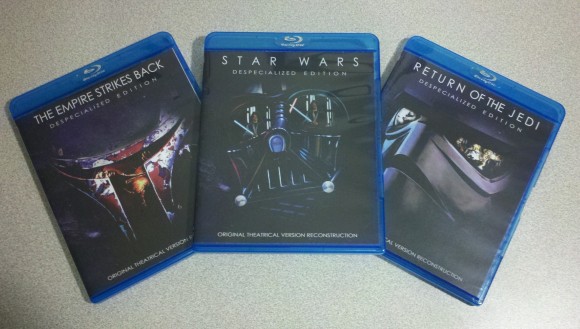
Harmy, King of the Nerds!
UPDATE: Since writing this original post, Star Wars has been made available in an even better format than Harmy’s Despecialized. Since people still link and check this post occasionally, I wanted to mention Project 4K77 which has taken a copy of the original theatrical negative and scanned it in 4K, releasing versions with and without digital noise reduction. While not quite as crisp as Harmy’s, this is my favorite version of the original film by far. There’s also a Project 4K80 for Empire Strikes Back and Project 4K83 for Return of the Jedi.
So, with that out of the way, what can you do if you do wish to involve the prequel trilogy? Maybe you don’t want to mess around with fan edits or the pirate bay, and you just want to watch the official Blu-rays with your kids. Maybe you’ve accepted that the original theatrical editions are no longer considered canon, and you’re a nerd that cares about things like that. Hell, maybe you actually like the prequels (seriously?).
Whatever your reason, if you are showing someone the official editions of Star Wars for the first time, you have to make a decision about which order to watch the films.
Release Order vs Episode Order
There are two obvious options for watching the Star Wars saga.
- Release Order - Watch the films in the order they came out, recreating your experience with the films for someone new to them.
- Episode Order - Watch the films in the order George Lucas intends, starting with Episode I and going straight through to Episode VI
There are two critical flaws with both of these orders, unfortunately, that prevent either from being appropriate.
The problem with Episode Order is that it ruins one of the biggest twists in movie history If you think that this reveal doesn’t matter since it’s common knowledge, I suggest you watch the looks on these kids’ faces. If a newcomer to the series has managed to avoid having it spoiled for them, watching the films in Episode Order would be like watching the ending of The Sixth Sense first.
The other problem with Episode Order is that the prequels don’t really have a story. They’re just background for the real story, which is Luke and his new friends trying to defeat the Empire. Watching 3 films of backstory is boring if you’ve never seen the films they’re the background to. Hell, that’s why George Lucas made Star Wars (later renamed A New Hope) first - it was the most interesting story he had in his brain at the time. Starting someone off with Episode I is a surefire way to ensure they don’t make it through the entire franchise.
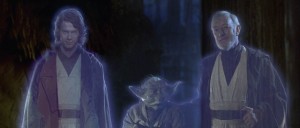
Unfortunately, Release Order also suffers from a problem, created by a single shot. If you’re watching the official releases and you view the original trilogy first, then at the end of Episode 6, Luke looks over at his mentors, Ben Kenobi and Yoda, and suddenly they are joined by… some random creepy looking teenager who needs a haircut. Placing Hayden Christensen in the ending of Jedi, since he’s not in ANY of the other films, turns an ending that should be celebratory into one that is confusing for the viewer. The fact that Christensen looks like he’s undressing someone with his eyes doesn’t help. This moment robs the most important moment from the ending of Return of the Jedi from its emotional impact.
So neither order is really ideal. What to do?
Introducing: Machete Order
How can you ensure that a viewing keeps the twists a surprise, while introducing young Anakin before the end of Return of the Jedi?
Simple, watch them in this order: IV, V, II, III, VI. You may notice Episode I is gone. I’ll get to that in a second.

I’ve dubbed this “Machete Order” on the off chance it catches on because I’m a vain asshole. (UPDATE: It did!)
(please note that from this point on I’ll be mentioning twists and plot details of the films so this is your official SPOILER WARNING for a movie that came out over 37 years ago because internet commenters will complain about literally anything)
George Lucas seems to believe that Star Wars is the story of Anakin Skywalker, but it’s really not - at least, not effectively. Anakin doesn’t have an interesting arc - he gives into what is presented as overwhelming temptation. This is relatable, but it’s not terribly interesting. Anakin only has an engaging character turn at the end of Jedi when he’s redeemed, but that’s not as a character, it’s as a goal - something for the character we’ve been invested in for 3 movies (Luke) to accomplish. Anakin is, at this point in the story, a personified proxy for the entire galaxy. Saving Anakin from the Dark Side just puts a human face on saving the Galaxy from the Empire, and it proves Luke right for his unwillingness to give up on his father, even though his attempts to save him risk the entire mission.
Effectively, this order keeps the story Luke’s tale. Just when our main man Luke is left with the burning question “did my father really become Darth Vader?” we take an extended flashback to explain that it’s true. Once we understand how his father turned to the dark side, we go back to the main storyline and see how Luke is able to rescue him from it and salvage the good in him, which is the only way to destroy the Empire.
Putting the prequels in the middle in general (which a commenter has pointed out is called Ernst Rister order) allows the series to end on the sensible ending point (the destruction of the Empire) while still beginning with Luke’s journey. The prequel backstory comes at the perfect time, because The Empire Strikes Back ends on a huge cliffhanger. Han is in carbonite, Vader is Luke’s father, and the Empire has hit the rebellion hard. Delaying the resolution of this cliffhanger makes it all the more satisfying when Return of the Jedi is watched.
Narratively, it’s just like a movie that starts with a big opening, then fades to “2 years earlier” for most of the movie, until it catches up with the present time and concludes.
Why Skip Episode I?
Look, I’m not going to sit here and bag on how crappy Episode I is. I’m not even going to try and act like Episode II is better or tell you Episode I ruined my childhood or anything like that. It didn’t, it’s just a movie that isn’t very good.
The reason to skip Episode I isn’t that it’s bad, it’s that it’s irrelevant. If you accept my suggestion that Star Wars, the saga, is really about Luke’s journey and his decision to accept his hero’s burden by saving not only the galaxy from the Empire, but his father from the dark side as well, then you’ll find that everything that happens in Episode I is a distraction from that story.
Seriously, think about it for a minute. Name as many things as you can that happen in Episode I and actually help flesh out the story in any subsequent episode. I can only think of one thing, which I’ll mention later.
Every character established in Episode I is either killed or removed before it ends (Darth Maul, Qui-Gon, Chancellor Valorum), unimportant (Nute Gunray, Watto), or established better in a later episode (Mace Windu, Darth Sidious). Does it ever matter that Palpatine had an apprentice before Count Dooku? Nope, Darth Maul is killed by the end of Episode I and never referenced again. You may as well just start with the assumption that Dooku was the only apprentice. Does it ever matter that Obi-Wan was being trained by Qui-Gon? Nope, Obi-Wan is well into training Anakin at the start of Episode II, Qui-Gon is completely irrelevant.
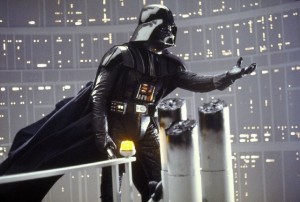
Search your feelings, you know it to be true! Episode I doesn’t matter at all. You can start the prequels with Episode II and miss absolutely nothing. The opening crawl of Episode II establishes everything you need to know about the prequels: a bunch of systems want to leave the Republic, they are led by Count Dooku, and Senator Amidala is a senator who is going to vote on whether the Republic is going to create an army. Natalie Portman is called Senator Amidala twice in the first 4 minutes of the movie, so there’s no question of who’s who.
What Gets Removed?
Here’s some stuff that you no longer have to see as part of your Star Wars viewing experience, thanks to skipping Episode I.
- Virtually no Jar-Jar. Jar-Jar has about 5 lines in Episode II, and zero in Episode III.
- No midichlorians. There is only one reference to midichlorians after Episode I, and in the context it appears to mean something as benign as “DNA.”
- No Jake Lloyd. Sorry Jake, I never really wanted to see Darth Vader as a little boy.
- No confusing Padme/Queen switcheroo. The whole subplot with Padme and her decoy makes absolutely no sense. It’s clear that this was just so people could interact with Padme without knowing she was the Queen, but it’s incredibly convoluted and pointless.
- Less confusing master/apprentice relationships. Darth Sidious is training Count Dooku, Obi-Wan is training Anakin. No other trainer/trainee relationships exist to confuse the backstory. Fewer characters to learn about, so the story is more focused.
- No virgin birth. We simply don’t know or care who Anakin’s father is, and the botched implication that Palpatine knows is gone.
But like I said, booting Episode I isn’t merely about pretending a crappy movie doesn’t exist. Viewing Episode II immediately after V and Episode III immediately before VI actually tells the story better than including Episode I does. In fact, I think it tells Luke’s story better than leaving the prequels out entirely.
Why Does This Work Better?
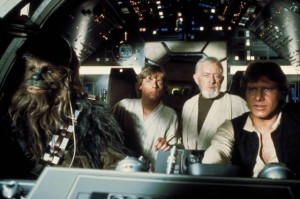
As I mentioned, this creates a lot of tension after the cliffhanger ending of Episode V. It also uses the original trilogy as a framing device for the prequel trilogy. Vader drops this huge bomb that he’s Luke’s father, then we spend two movies proving he’s telling the truth, then we see how it gets resolved. When Empire first came out, lots of people thought Vader was lying to Luke. It wasn’t “proven” true until Obi-Wan confirms it in Jedi, but then it’s immediately followed by Obi-Wan’s “a certain point of view” justification. Inserting the prequels turns this reveal into a “show, don’t tell” situation - we don’t just hear Obi-Wan say it, we see it.
With Machete Order, the Star Wars watching experience gets to start with the film that does the best job of establishing the Star Wars universe, Episode IV, and it ends with the most satisfying ending, Episode VI. It also starts the series off with the two strongest films, and allows you to never have to either start or end your viewing experience with a shitty movie. Two films of Luke’s story, two films of Anakin’s story, then a single film that intertwines and ends both stories.
Beyond this, Episode I establishes Anakin as a innocent little kid. But Episode II quickly establishes him as impulsive and power-hungry, which keeps his character consistent with eventually becoming Darth Vader. Obi-Wan never really seems to have any control over Anakin, struggling between treating him as a friend (their very first conversation together in Episode II) and treating him as an apprentice (their second conversation, with Padme). Anakin is never a carefree child yelling “yippee”, he’s a complex teenager nearly boiling over with rage in almost every scene. It makes much more sense for Anakin to have always been this way.
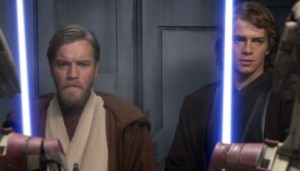
In the opening of Episode II, Padme refers to Anakin as “that little boy I knew on Tatooine.” The two of them look approximately the same age in Episode II, so the viewer can naturally conclude that the two of them were friends as children. This completely hides the totally weird age gap between them from Episode I, and lends a lot of believability to the subsequent romance. Scenes in which they fall for each other seem to build on a childhood friendship that we never see but can assume is there. Since their relationship is the eventual reason for Anakin’s fall to the dark side, having it be somewhat believable makes a big difference.
Obi-Wan now always has a beard for the entire duration of the series, and Anakin Skywalker always wears black. Since these two characters are played by different actors (and are the only characters in the series with such a distinction), having them look visually consistent does a great deal toward reinforcing they are the same people.
Update: Den of Geek has also written up an article highlighting some more things that work better in Machete Order that I didn’t mention. I particularly like the extra dimension it gives Yoda.
What a Twist!
This order also preserves all twists, and adds a new one (or rather, makes one more effective).
As mentioned, this order preserves the surprise that Darth Vader is Luke’s father. For what it’s worth, it also preserves the surprise that “Yoda, the Jedi Master who trained [Obi-Wan]” is the tiny green guy on Degobah. Both of these were surprises for moviegoers at the time and, though it’s somewhat unlikely that culture and cereal boxes and whatnot won’t ruin these surprises for someone, at the very least they aren’t ruined by Machete Order.
George Lucas knew that watching the films in Episode Order would remove the Vader and Yoda surprises, so he added the Palpatine twist to compensate - that the friendly Senator Palpatine is actually a Sith Lord and creates the Empire. Since we don’t really meet the Emperor until Episode VI (you only see him for one scene, in hologram, in V), this order preserves the prequel’s twist. This twist is actually ruined by Episode I, which establishes that Darth Sidious is manipulating the Trade Federation in the opening scene of the film, but he’s on screen so much that it’s pretty obvious Sidious is Palpatine when we see Palpatine later on.
If you skip Episode I and go straight to II, all we ever see is that Count Dooku is leading a separatist movement, all on his own. Dooku tells Obi-Wan that the Senate is under the control of a Sith lord named “Darth Sidious”, who we haven’t seen at all yet. At the end of the movie, after Dooku flees from Geonosis, he meets with his “master”, who turns out to be Darth Sidious. This is the first time we realize that the separatist movement is actually being controlled by Sidious, and it’s so brief that it doesn’t give the audience as much of a chance to realize he’s Palpatine (remember, nobody has ever referred to “Emperor Palpatine” by this point in the series, he’s only called The Emperor in Episode V).
Below is the entirety of Sidious’s screen time in Episode II. With Machete Order, this is the only chance you have to realize that Chancellor Palpatine is behind everything until he tries to recruit Anakin to the Dark Side in Episode III. Personally I think it’s still a bit of a giveaway given Ian McDiarmid’s creepy acting as Palpatine (plus the cleft chin), but at least kids have a chance at not realizing it too early this way.
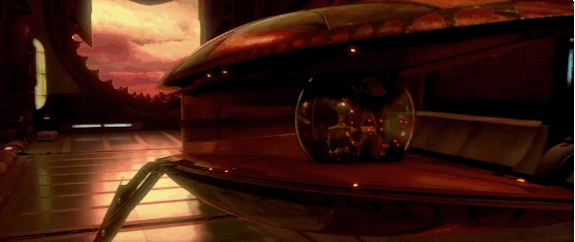
Machete Order also keeps the fact that Luke and Leia are siblings a surprise, it simply moves the surprise to Episode III instead of VI, when Padme announces her daughter’s name. This is actually a more effective twist in this context than when Obi-Wan just tells Luke in Return of the Jedi. We get to find out before Luke, and we discover Padme’s carrying twins alongside Obi-Wan when the Gynobot tells him (a surprise at this point). Luke’s name is first, so when Padme names the other kid “Leia” it’s a pretty shocking reveal. With Release Order, this “twist” happens when Yoda tells Luke there’s another Skywalker in Return of the Jedi, and Luke guesses it’s Leia with Obi-Wan’s ghost one scene later. With Episode Order, it’s not a surprise at all, as we have no idea who Luke and Leia are yet. As an added bonus, there are now about 5 hours of film between the discovery that they are siblings and the time they kissed.
What Works Best?
The real value of Machete Order becomes clear when you watch Return of the Jedi.
Remember, we see in Episode V that Luke’s vision in the cave on Degobah is that he turns into Darth Vader, then we find out Vader is his father. Then we watch Episodes II and III, in which his father turns to the dark side in order to protect his loved ones. After that we go back to VI, where eventually Luke confronts the Emperor.
With Machete Order, we never saw Anakin as a little kid, he’s about the same age the first time we see him as Luke was in Episode IV. Hayden Christensen’s incessant whining in Episode II is actually less annoying now, because it’s helping to link the character to Luke, who was just as whiny in Episode IV. In other words, because we skipped Episode I, the parallels between Luke and Anakin are much stronger. We’ve seen Obi-Wan train just the two of them, and never had to see anyone training Obi-Wan himself. The viewer is naturally linking the paths of these two characters together at this point, moreso than if he or she watched Episode I.
The first time we see Luke in Return of the Jedi, he is entering Jabba’s palace and the musical cue sounds a bit like the Imperial March. The way he enters with the light behind him makes it unclear if he is Luke or Vader for a bit, and when we finally see him, he’s wearing all black. Then, he force chokes Jabba’s guards, something only Vader has done in the series! Nobody else sees him do this.
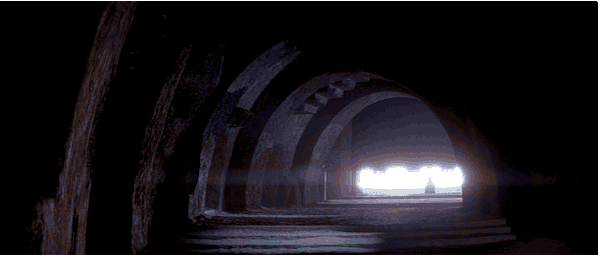
When he confronts Jabba, he warns him that he’s taking his friends back. He says Jabba can either profit from this, “or be destroyed.” We just heard Anakin make a similar threat to Obi-Wan, “don’t make me destroy you.” Furthermore, he tells Jabba “not to underestimate my power.” The last time this phrase was used, it was in the same duel with Obi-Wan. When watching Jedi on its own, Luke just seems a tad arrogant during these scenes. When watching Jedi immediately after watching Revenge of the Sith, the message is clear: Luke Skywalker is on the path to the Dark Side.
Why does this matter? Because at the end of Jedi, Luke confronts the Emperor. The Emperor explains that the assault on the new Death Star is a trap and that his friends are going to die, and he keeps taunting Luke, telling him to grab his lightsaber and fight him. The film is trying to create a tension that Luke might embrace the Dark Side, but it was never really believable. However, within the context of him following in his father’s footsteps and his father using the power of the dark side to save people, with Luke’s friends being killed just outside the Death Star window, this is much more believable.
Shortly after, Luke goes bananas and beats the hell out of Vader, clearly succumbing to his anger. He overpowers Vader with rage and cuts his arm off, just like Anakin did to Windu in Episode III. Having the very real threat of Luke following in his father’s path made clear by watching II and III just before VI heightens the tension of this scene, and makes it that much more satisfying when Luke refuses to follow in his father’s footsteps and rejects the dark side. This makes Return of the Jedi a better, more effective film.
What Doesn’t Work Better?
Machete Order isn’t perfect. There are a few tiny issues that arise watching the films in this order.
The Kamino sequence is a little confusing. Since the cloners seem to have been “expecting” Kenobi, it leads the viewer to wonder if Episode I showed him creating the clone army or something. Hilariously, Episode I doesn’t actually explain anything or make this scene less misleading, but the fact that the viewer knows a movie got skipped amplifies the confusion.
Qui-Gon is mentioned once in Episode II and once in Episode III. Luckily, both times he is mentioned, his relationship to the characters is restated, so it works. Dooku explains that Obi-Wan’s “old master, Qui-Gon” was once Dooku’s apprentice, and then in Episode III Yoda tells Obi-Wan that Qui-Gon has learned to communicate after death. It’s alright, just a little weird.
Episodes II and III both talk about Anakin being part of a prophecy which is never really explained (because it was explained in Episode I). This is unfortunate, but on the plus side the last time it’s mentioned in Episode III, Yoda says it may have been misinterpreted. Frankly I consider the removal of most of the “prophecy” stuff one of Machete Order’s strengths, but there’s no denying it’s brought up quite a bit in Episode III.
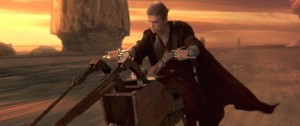
The weakest part of this order is when Anakin returns to Tatooine. We don’t know his mother is a slave, and we don’t know he built C-3P0. When he has visions of his mother dying and returns, Watto says he sold her. That’s not something you expect to hear about a Jedi’s mother, so it’s a bit jarring. When Anakin goes to the Lars moisture farm, Threepio calls him “the maker” and they act like they know each other, but it’s not stated outright that Anakin created Threepio. This definitely draws attention to the fact that one of the films was skipped. This is the one, singular thing made genuinely more confusing by skipping Episode I.
Give It A Shot First
I’ve tried this order myself, and lots of other folks who happened upon this blog post have tried as well, and for the most part people seem to really enjoy it. Next time you break out the Blu-rays, give it a shot.
You might be wondering if it’s worth skipping II and only watching III, just to establish young Anakin in time for Jedi. I don’t recommend this, every character you need to know for Episode III who was introduced in Episode I is reintroduced in Episode II with a quick line of dialogue, but Episode III just assumes you know who everyone is. Ham-handed as it is, Anakin’s love for Padme is the ultimate reason for his fall to the dark side, and Episode II has most of that. Additionally, without seeing the Clone Army being created in Episode II, seeing the Jedi fight alongside them in III would be extremely confusing, since they look almost exactly like Stormtroopers in III. Narratively, I don’t think skipping II works.
Some people claim that Episode I isn’t that bad, and shouldn’t be removed (again, it’s not that it’s bad, it’s that it’s not relevant to Luke’s journey in the way that Episode II and III are). Lots of people like the pod race or Darth Maul or Qui-Gon or they were born in 1992. Whatever your reason, if you want to watch Episode I I’d recommend doing so separately, sort of like an “Anthology” film. After all, Machete Order doesn’t interfere with canon, everything is canonically compatible with Episode I (or any later ones) because we’re not watching fan edits.
Many people also object that you don’t understand why Anakin falls to the dark side, since the reason is basically that Obi-Wan wasn’t ready to train him, and only did so because Qui-Gon insisted as his dying wish. With Machete Order, there’s no Qui-Gon, so this leaves a gap. But the thing is, do we really need to know why Anakin succumbs to the Dark Side? Isn’t it enough that it’s tempting, and that he thinks he can use it to save his wife? That’s what makes it relatable - that it’s “more seductive.” Besides, you could go “why?” forever back in time, but nobody is demanding everyone read the “Star Wars: Jedi Apprentice” series about Qui-Gon training Obi-Wan so you understand what happens before Episode I.
Shortly after first writing this post, I discovered my college-aged brother-in-law’s girlfriend had never seen any Star Wars films and wanted to watch them all over winter break. Armed with the new Blu-rays, we all went about watching them, and I showed them in Machete Order. It honestly works even better than I originally anticipated - it’s almost as if this is somehow the intented order. There’s a great pattern here, taking the viewer on a series of emotional ups and downs. IV ends with a victory that seems to have some sinister undertones, then V is dark and unresolved with a cliffhanger, II ends with victory with sinister undertones, then III is dark and unresolved with a cliffhanger again. It works incredibly well, and when III ended everyone demanded we immediately watch VI to see how everything gets tied up.
Perhaps most importantly, the flaws with Machete Order seem to not be problematic at all. When Anakin returned to Tatooine in II, the conversation with Watto immediately indicated to her that Anakin’s mother was a slave. She asked why Anakin never went back to free her after becoming a Jedi, but Episode I doesn’t really provide an answer to that.
The thing she had the most trouble with was when Leia and Luke are talking in ROTJ, and she talks about how she remembers her mother, her “real mother” (so Leia clearly knows she’s adopted). With a few movies between III and VI, one might forget about this line, but watching VI right after III made her stop and ask “wait, what? How does she remember her mother?” There’s no way around this point of confusion, watching Episode I or watching them in another order doesn’t really help.
I asked her if she found Jar-Jar annoying and she asked “who’s Jar Jar?” - Mission accomplished.
Updates!
I’ve had lots of requests to update this post with various answers to questions. To avoid this post being longer, I’ve decided to create a second post with all of those updates.
In particular, the other post addresses the question of my suggested order taking into account the new Disney-era movies and Star Wars Story standalones, so check that out if you’re curious.